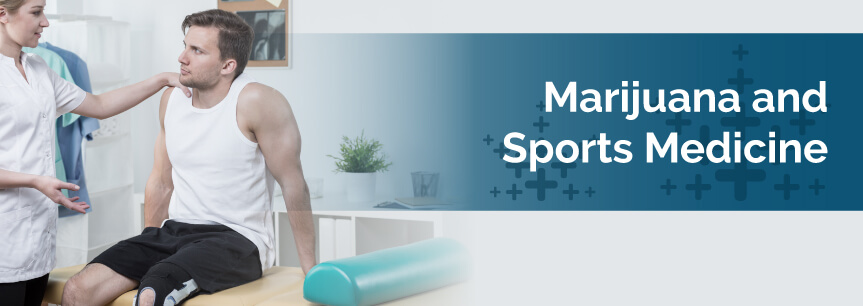
For decades, sports athletes — particularly football players — have managed their pain with powerful prescription painkillers, post-game beers and OTC anti-inflammatories. The professional sport’s dependence on drugs to manage pain has now caused the Drug Enforcement Administration to open an investigation and may just be the subject of a federal lawsuit.
The use of marijuana in the nation’s professional sports leagues remains controversial. Cannabis on the National Football League’s banned substances list, but increasingly, players are calling for the league to reassess its position and consider adopting a fairer cannabis policy.
A study involving 644 Retired Players Association Directory NFL players in 2009 who answered an over-the-telephone survey revealed the following:
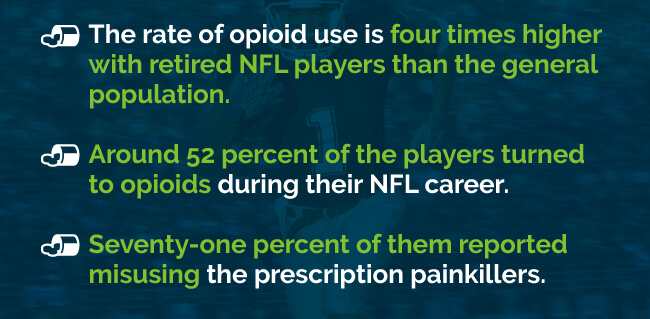
Former Baltimore Raven player Eugene Monroe, who at the time was 30 years old, said his body was damaged and the pain doesn’t ever go away. The Baltimore Ravens released him last year after he became the first active player to ask the league publicly to allow medical cannabis. According to Monroe, he has to manage his pain somehow, going on to say:
“Managing it with pills was slowly killing me. Now I’m able to function and be extremely efficient by figuring out how to use different formulations of cannabis.”
There’s also the NFL’s concussion crisis. Many of its players have to retire early and some choose not to play anymore because of potential long-term consequences that don’t appear until later in life from dealing with too many head injuries. CBD, the non-psychoactive part of weed, can potentially treat and even prevent chronic traumatic encephalopathy (CTE), which is a degenerative brain disease found in athletes who have a history of trauma to the brain.
Advocates of marijuana in professional sports say there’s a healthier and safer alternative available: medical cannabis. The thought is that the NFL could invest in some research on medical marijuana to see how it improves its players’ health.
Medical weed offers professional sports many benefits. It can potentially help with a variety of symptoms, including:
Marijuana is an analgesic. It can help ease the pain while you exercise and after. Many professional athletes may be inclined to use pot after their workouts to manage their achy and painful muscles and leg soreness.
Both THC and CBD can be helpful in managing the inflammation that occurs after exercise. Cannabinoids offer potent anti-inflammatory components which exert their effects through the inhibition of cell proliferation, induction of apoptosis, induction of T-regulatory cells (Tregs) and suppression of cytokine production.
CBD can help decrease inflammation while protecting the lungs, heart and brain during injury and after. Researchers continue to study CBD’s short-term neuroprotective effects in the brain for possible treatment of sports concussions.
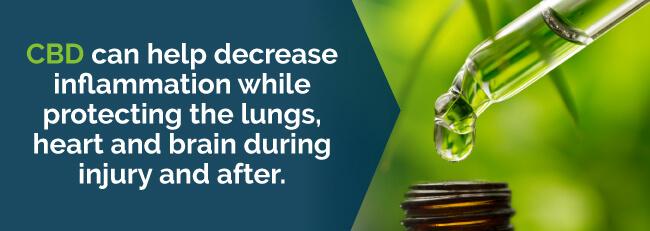
Cannabinoids also have antispasmodic components. Often, athletes suffer muscle spasms due to:
Cannabinoids have sedative and relaxing effects on users. They’ve been known to treat insomnia when concentrations of the CBN in cannabis approaches one percent by weight. Healthy athletes require plenty of sleep at night to help their muscles recover and grow.
You may be wondering why athletes would smoke weed knowing they need to maintain lung health in their professional sports career.
An extensive 20-year study published in 2012 and involving more than 5,000 adults showed that smoking one marijuana joint a day for seven years or smoking one marijuana joint a week for 20 years produced no negative effects on lung function.
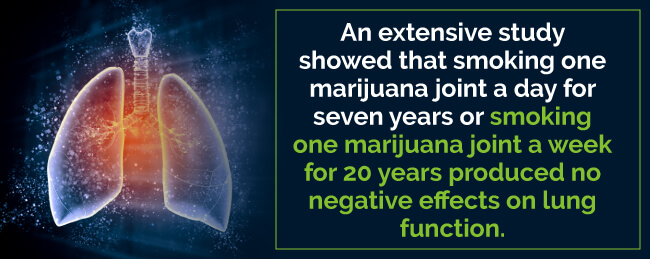
Evidence in the study suggests the individuals who participated actually saw slight improvements in their lung capacity. Researchers believe the deep inhales required to smoke cannabis the traditional way could contribute to better lung function with time.
Head injuries that happen in professional sports like football can sometimes be far worse — they may result in chronic traumatic encephalopathy (CTE), which occurs from repetitive blows to the head. Symptoms of this type of injury may include:
Certain ratios of cannabinoids like CBD offer therapeutic benefits that relax the central nervous system and ease pain. THC offers mood-altering abilities that can help with irritability and moodiness that can also be a result of long-term problems from head traumas.
Medical marijuana helps balance the natural endocannabinoid system of your body. This system is a complex system of receptors in your peripheral and central nervous systems, connective tissues, organs, glands and immune system.
CBD has anti-convulsant, anti-psychotic, analgesic and anti-inflammatory effects. It even shows neuroprotective properties and decreases oxidative stress.
Neuroscientists from the University of Sao Paulo in Brazil found smoking weed can be helpful for certain activities like extreme sports since it:
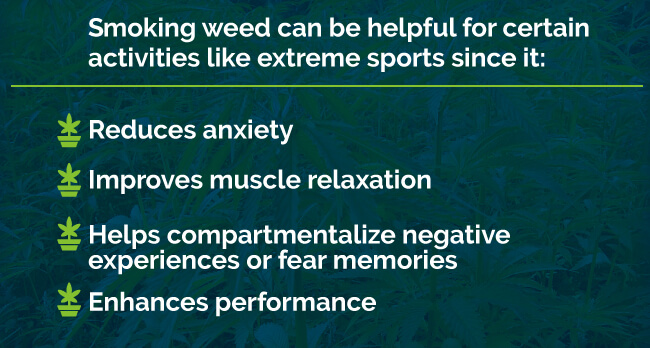
Marijuana and sports recovery go hand-in-hand, since improving sleep quality while healing from an injury — or even simply preparing for an event — is vitally important. This may help an athlete with their performance when they’re looking at numerous competitions in a short period.
One of the biggest benefits of medical cannabis in professional sports offers is that marijuana can potentially replace athletes taking painkillers, such as opioids. Opiates have always been the standard for serious sports injuries.
Opioids flood pain receptors while interrupting the pain signal to the brain and providing damping effects. However, when taken over time they can affect the hypothalamus and pituitary gland, which triggers what is known as panhypopituitarism. This causes symptoms of:
One player notes that it’s too simple for physicians to prescribe you a pain medication like Oxycontin, stating he was addicted to this drug for over five years. Many athletes play sports while on Percocet — but this medication makes you far groggier than applying a little cannabis oil on your skin.
Researchers are always finding new links between marijuana, athletic recovery and a decrease in opioid dependence. According to a couple of government-funded studies that the National Institute of Drug Abuse cites, medical cannabis products may play a role in lessening players’ dependence on opioids for pain control.
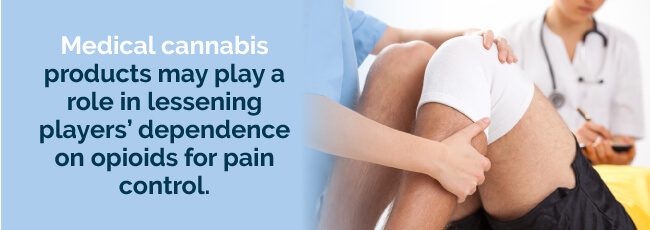
Over-the-counter painkillers and inflammatories can have side effects too. After working out intensely or during a training session, the athlete may be sore, tired or nauseous. It’s here where they’ll take naproxen or acetaminophen and a cold beer to help them relax and call it good. But what they don’t realize is that NSAIDs and acetaminophen can be dangerous — particularly when used on a regular basis. And, unlike NSAIDs and acetaminophen, marijuana doesn’t carry a risk of kidney or liver failure.
So the question is this: Why should professional athletes not use a less toxic, more powerful and naturally occurring medication like marijuana? We will get into the setbacks with marijuana in professional sports below, but first let’s go over how marijuana and sports medicine works.
Scientists found that THC provides some benefits like management for anxiety, pain and nausea. But the science surrounding CBD shows it also acts as a neuroprotectant and an anti-inflammatory, which raises hopes that cannabis may be valuable in preventing and treating head injuries. For instance, when inflammation occurs as a result of a sports injury:
Marijuana for sports injuries has anti-inflammatory effects that ease the pain routinely faced by athletes. Research shows that CBD increases anandamide (a molecule) that decreases pain and increases neuron production in the brain’s hippocampus region that impacts anxiety and mood. Substantial evidence showed that when compared with a placebo, medical cannabis is effective at handling chronic pain.
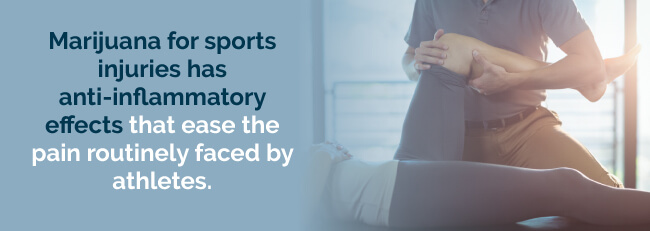
Marijuana for athletic injuries can also be beneficial for people with active lifestyles, like zealous mountain bikers, weekend exercise warriors and serious athletes. Athletes like these all likely have firsthand experience with muscle relaxants, opiates and NSAIDs. And these medications come with unwanted side effects, since physicians often prescribe them for the wear and tear of a lifetime of fitness, sports injuries or a weekend of playing hard.
There are still some setbacks with cannabis in professional sports that are holding back the use of marijuana. You’ll find some of them discussed below:
Marijuana is now legal for medicinal use or recreational use in over half the country on a state level. But federal law still classifies it as a Schedule 1 drug, which means U.S. officials believe cannabis to still have a significant risk of harm or abuse with no medical treatment use accepted. Cannabis is also still banned in professional sports. But should it be?
The NBA and NFL are especially harsh with their penalties for using cannabis. But the policies the league imposes are harmful to the players’ health. This is due to the league allowing players to consume alcohol and pharmaceutical painkillers but pushing them away from marijuana.
When you listen to sports radio shows about an athlete who uses marijuana, you commonly hear: “How could he be so stupid?” A question like this, unfortunately, is both popular and unfair.
What would they rather the athlete do — down a handful of pain pills each day with a fifth of alcohol? What if they made a choice to get drunk every night on the alcoholic drinks made by the companies that sponsor the NFL? Would they still get labeled as stupid?
The stigma around using cannabis is so powerful in professional sports that just finding out a player even tried cannabis would make that player virtually “untouchable” to many in the professional sports world.
Cannabis is currently legal in 28 states for medical use and eight states (and Washington, D.C.) for recreational use. However, it remains a banned drug within most professional sports. Athletes cannot use it. Some believe it’s time for the professional sports industry to get with the times and propose more rational cannabis policies.
The NFL continues to ignore marijuana’s medicinal benefits — particularly for treating the chronic pain that most, if not all, professional football players contend with.
One of the go-to methods of injury and pain treatment in professional sports is opioid painkillers. In fact, opioid medications have been “given out like candy” for a while now. Other players who are now retired have talked about becoming addicted to those medicines. They could benefit from cannabis, since it doesn’t come with the long-term addictive effects that prescription painkillers do.
Even using medical cannabis with painkillers can reduce athletes’ dependence upon the latter to manage their chronic pain. Some individuals may even be able to replace their painkillers completely with cannabis.
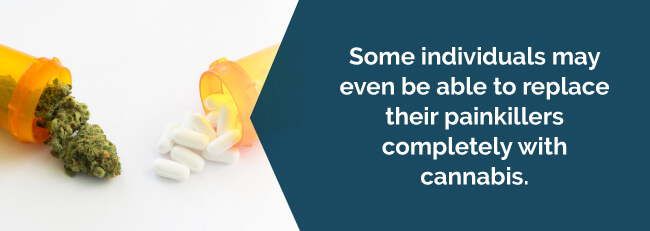
As legalization momentum grows nationally, many athletes hope this will change — particularly in the NFL, where the players’ constant companion is pain. Cannabis advocates say it could offer a better and safer way of managing this pain.
A mechanistic study can help researchers and doctors examine the brain of a human to see precisely how cannabinoids work or perhaps how a group of people will respond to them. Studies need to be conducted in a controlled setting to know the correct strength and dose of cannabis to administer.
However, scientists and researchers still have limitations with cannabis, since it holds a Schedule 1 classification. They’ll need to obtain several approvals from various agencies, which can take a lot of time. Having to get all the approvals needed to research drugs that are under the Schedule 1 classification can be burdensome and inhibits many researchers and scientists from being able to do science on cannabinoids without a lot of hassle.
But the NFL keeps its ban and the federal government holds firm because of the absence of enough scientific inquiry into cannabinoids, which could help change minds about cannabis. However, when it comes to medical cannabis, athletes should be able to use it in the states where it’s legal.
Meanwhile, the season of professional football rolls on and the pain goes along with it. For players, they continue to search for safer and better ways to ease their pain.
Contact sports take a heavy toll on athletes and medical cannabis could ease this burden. Below are some things that are happening right now that will hopefully gain attention for medical cannabis in professional sports:
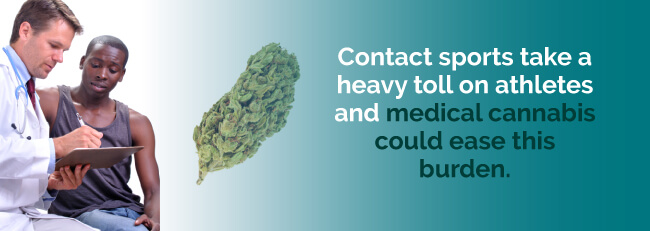
The Food and Drug Administration (FDA) hasn’t approved cannabis as an effective or safe drug for any application. However, it has approved a couple of drugs that contain a synthetic form of a substance in the cannabis plant and another drug which contains a synthetic substance that works much like marijuana compounds but isn’t currently in marijuana.
Even though the FDA hasn’t approved any drug product that derives from or contains botanical cannabis, it’s aware that there’s substantial interest in its use for treating several medical conditions like:
The FDA has essentially approved a couple of medications that put cannabinoids into your body through a pill form. One is for CBD that decreases inflammation and pain and treats addiction disorders and mental health issues. The other one is for THC that decreases nausea and increases appetite.
So, what can we expect in the future of medical marijuana in terms of professional sports?

Most cases concerning marijuana and its use in professional sports don’t involve event-day or in-game consumption. The testing threshold level is set now to detect whether in-competition use has occurred — not whether the subject used during the weeks or days before competition. The question becomes whether professional sports leagues need to step up and start doing the socially responsible thing: start making fairer cannabis policies.
To learn more about the medical marijuana industry, including how to secure your own medical pot recommendation, find a local marijuana doctor and sign up for the MarijuanaDoctors.com newsletter.
No Information on MarijuanaDoctors.Com should be used to diagnose, treat, prevent or cure any disease or condition. You can view our Full Disclaimer here.